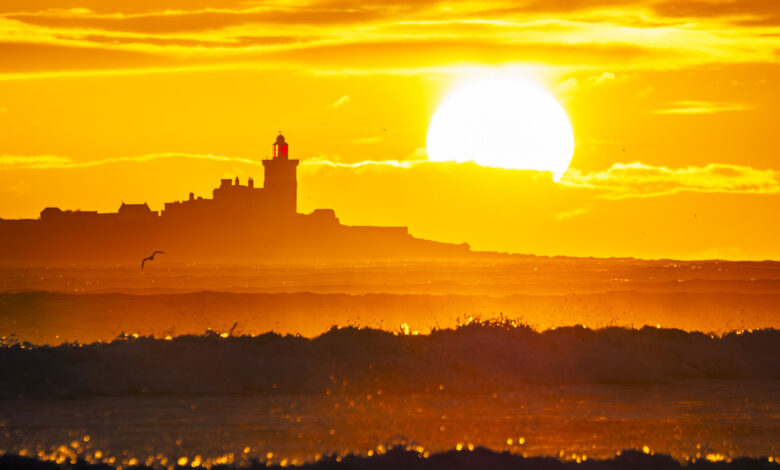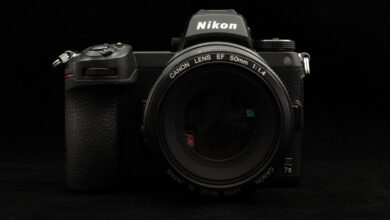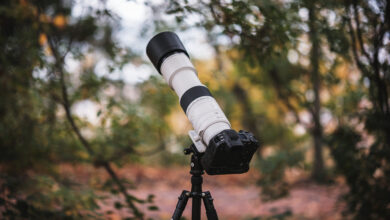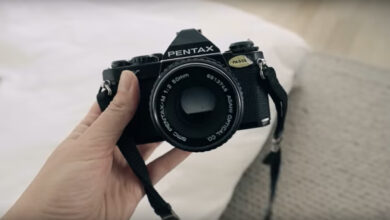Landscapes Are the Cannabis of Photography

Landscapes are often the gateway drug into other genres. Be careful; it can be addictive and lead you to harder photography. Here’s how to get high from what might seem a benign habit.
Landscape photography leaves you feeling happy and relaxed. Unlike weed, it doesn’t have the potential to bring about feelings of anxiety or paranoia. Nor does it lead to psychosis, hallucinations, schizophrenia, or long-term memory loss. However, you can get a high from standing by the sea at dawn and seeing our star rise above the horizon, experiencing a glorious sunset from a hilltop, or watching a mountain stream babble over rocks. It doesn’t come without its risks, though.
Okay, so that is a tongue-in-cheek analogy, but the activity of shooting landscape photography is shown to have some positive side effects on mental health. It gets you outside in nature, forces you to exercise, and allows you to concentrate on one thing and leave the worries of the world behind. You slow down and can either do it alone or in company. It is a social activity even if you don’t intend it to be; everyone comes to talk to me when photographing landscapes, usually just as the sun appears above the horizon.
Most, but not all, of the beginners who attend my workshops want to learn about shooting landscapes. That’s good news for them because landscape photography is a great place to start. There are formulas you can adopt to make great-looking photographs, and it’s possible to come away with a “wall-hanger” very early in your photographic career.

How to Appreciate Landscape Photography
Let’s start with a universal truth: appreciating any photograph is subjective. I am blessed because I like every photo. I think they are all incredible.
Each successive image is the culmination of every step of human endeavor, starting over 200 years ago when, in 1816, Joseph Nicéphore Niépce began working on how to fix an image permanently. His earliest surviving work is a landscape, “View from the Window at Le Gras,” from around 1826. Ever since, both camera technology and photographers’ techniques have constantly evolved and branched out. I feel all that history behind all smartphone snaps and every carefully composed attempt at a masterpiece.
If you approach viewing landscapes with imagination, you can feel what it was like for the photographer to be standing there. You can understand what they experienced and were conveying with the shot. However, it’s more likely that you will impose your interpretation on a photograph, and that will reflect your own personality, prejudices, and imagination.

There’s More to Landscape Photography Than Meets Your Eye
It’s not unusual to hear some people casting negative opinions on others’ work, especially landscapes. This always says much more about the critic’s shortcomings than the photographer’s abilities. Putting aside the snide jealousy that fuels the bile aimed at anyone more successful, negativity towards an image or genre shows an inability of the viewer to understand it. If you cannot appreciate or find meaning in a photograph, the issue is with you, not the picture. But worry not; it is something you can learn if you are prepared to put in the study time.
By analyzing others’ photos, you can learn from landscape photographers whose work especially appeals to you and those who don’t. You can then emulate or reject what they do depending on your tastes.
All photographers will be attracted to separate aspects of a scene in front of them. Consequently, their photo will articulate their interpretation of that landscape. Their approach doesn’t have to be the same as yours if you were at the same location at the same time. That’s a good thing. Otherwise, every shot from every photographer would be the same.

Getting High and Low
Landscape photography can be formulaic, and there is nothing wrong with that. By employing or deliberately rejecting any of the many compositional techniques available, the photographer can piece together an image that tells the story they want to tell.
Many photographers want to show the world uniquely, employing techniques to produce an interpretation of a scene that is unseen by most people. The easiest way to do that is to position your camera’s lens where the human eye rarely goes. For example, you can put your camera high up or low down. Either way, you are creating a different look from how most people view a scene because ordinary people see the world at eye level.
Elevating the camera shows more of the world between the camera and the horizon. Take the following shot, for example. The camera was situated several feet higher than the water level. Therefore, the light trail reflected across the water was long.

With a high setting, the angles of converging lead-in lines will be more acute than when set low. On the other hand, putting the camera down low will foreshorten that distance. Also, lead-in lines will converge more rapidly at a more obtuse angle. It reduces the perspective, making the horizon closer to the camera.

Leading Lines
Those leading lines take the eye deep into the picture. They can be continuous, like the railings of a fence or the sides of a road, or they can comprise separate objects, like a line of rocks. The brain automatically infers a line despite no physical connection between them.
Usually, leading lines are considered desirable in photographs, but they can be rejected too.

Get in Close
The great Robert Capa famously suggested that if your photographs are not good enough, you are not close enough. So, bringing your camera into proximity with foreground interest can help make your image more compelling. Again, it is putting your camera where a human eye rarely goes.

However, like all these suggestions, it is possible to make landscape photos with no foreground subject.

Horizons and Where to Put Them
Choosing where the horizon and subjects sit in a photo is also an important aspect of composition. The rule of thirds is sometimes disparaged, but it works. Its proportions add balance to a photo. If you don’t know how that works, imagine a 3 x 3 grid, like a tic-tac-toe board overlaying your photo. Use that to place the horizon on one of the horizontals and place objects of interest in the cross-over points of the verticals. Alternatively, you can position different subjects in separate segments.
Alternatively, symmetry might suit the photograph better.

Many other compositional frameworks are appealing and can help you with subject placement within the frame. Common ones include the golden section, symmetrical, triangular, cross, and diagonal layouts. You can, of course, break the common approaches altogether. Those are just the starting points of composition, and you’ll find dozens of books written on the subject.
Balance in a landscape photograph is important. Balancing an image involves the positioning of objects within the picture. Having a big, heavy object on one side of the frame can look odd if not balanced with something similar on the other side. We are used to the effects of gravity, so we expect more visual weight at the bottom of the frame than at the top.
Thinking back to primary school, you may have played with a balance in a math lesson. You could maintain equilibrium with a heavy object on one side near the fulcrum and a lighter object at the farthest end on the other side. The same is true for photography and art, and this is called a steelyard composition.
There is so much more to composition than can be written here in this short article, but it is worth researching and reading up on. But most important is the act of repeating these different approaches to composition. You can train your eye to see what works for you and what doesn’t. With practice, they become second nature. You won’t even consciously think about it.
Adding Dynamic Elements to a Landscape
One of the things that is worth considering is adding people or animals to a landscape. Including a bird or a person in a landscape gives an idea of scale. It also adds a story element to the photo and generates questions. Why is that person there? Who is it? Why are they alone? And so on.

Bending the Genre
Bending the genre happens when the person or animal becomes more dominant in the photo. At some point, it becomes a form of street photography, a portrait, or a wildlife shot. But that’s okay too. There are no hard and fast rules dictating what you should be doing. It’s your camera and your art.

Gear for Taking Landscape Photographs
Cameras
ll cameras are suitable for taking landscape photographs. However, some features will help you to achieve the best results more easily. Having an articulated rear screen is a must for me, especially when shooting at a low level. System weight may also be an important factor because you want to walk to a location without breaking your back.
Being able to connect a phone to your camera via Wi-Fi means that you can see the scene on a larger screen and remotely trigger the shutter without jogging the camera.
If you want to try long exposures, then you want the longest shutter value in manual mode, aperture priority, or shutter priority to be at least 60 seconds. Or, have a hands-free method of shooting in bulb mode.
Other features might be important depending on where you shoot. Good quality water and dust sealing that protects the camera from airborne seawater and sand are also essential for me.
Different cameras have features that are especially useful for landscape photographers. For example, there are some unique features on my OM System cameras I use all the time. In bulb mode, I can watch a long exposure gradually develop on the live view screen and, for star trails and light painting, shooting a single image and then only adding new light to it is possible. It also has Neutral Density and Graduated Neutral Density functions built into the camera, plus it uses AI to focus nighttime shots so stars and foreground are both sharp. You can read more about those by clicking here.
Meanwhile, some Pentax cameras, coupled with an add-on GPS module, allow the Shake Reduction (SR) mechanism to track the movement of the sky, thus keeping stars pin sharp on long exposures.

Lenses
Most landscape photographers use wide-angle lenses, although you can use other focal lengths too for specific effects. Wid angle lenses make the background appear smaller and farther away than the foreground, adding depth to the photo. Meanwhile, a telephoto lens makes the background seem much closer to the foreground, thus flattening the appearance of the scene.
Although good quality lenses are always desirable for sharper images, there isn’t always the necessity for fast lenses with ultra-wide apertures for landscape photography because you will be reducing the aperture to get more depth of field anyway. Some manufacturers make great quality f/4 professional-grade lenses. Those are fabulous for landscapes and cheaper and smaller than their faster equivalents.
Nicco Valenzuela wrote an excellent article about lenses that is worth reading.
Other Ephemera
ND filters and graduated ND filters are a handy addition to your kit bag. However, the latter is becoming less necessary as cameras can better show the details in the highlights and the shadows than they could a few years ago.
There are also useful phone apps like Photopills that can help you plan the shot. Your local weather service app is also worth installing.
Finally, although many cameras have image stabilization that can make a tripod redundant in many circumstances, a good quality tripod will make you slow down and take your time setting up the shot.

In Conclusion
As I hinted in the introduction, landscape photography can lead to dabbling in other genres. Once you have discovered the delights of getting up at dawn or heading out at sunset to get the best light, it’s easy to become hooked on photographing other subjects that also benefit from that golden glow. But remember, once you are addicted, before you know it, your spouse is a photography widow/widower, and your bank account is whittled down to nothing because of the never-ending supply of gear you need to feed your photography habit.
On a Serious Note
Although I have made light of photography addiction in this article, everyone is aware that substance abuse is a serious issue and can be extremely upsetting. if you or someone close to you has an addiction then there is available where you live. In the USA, contact the Substance Abuse and Mental Health Services Administration’s (SAMHSA) National Helpline at 1-800-662-HELP (4357). Here in the UK, the National Health Service is your first port of call. Other nations will have services that should be easy to find using an internet search.




